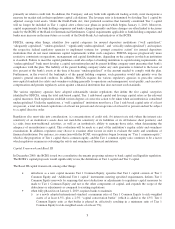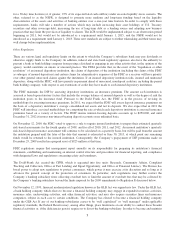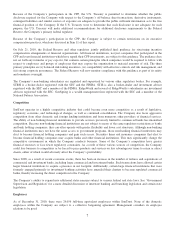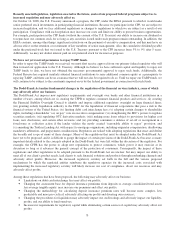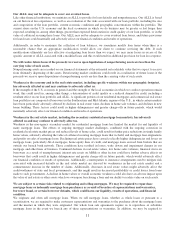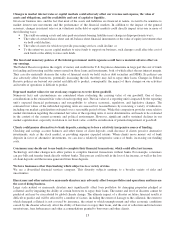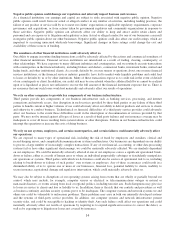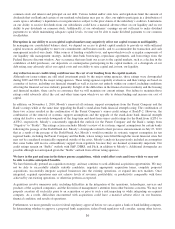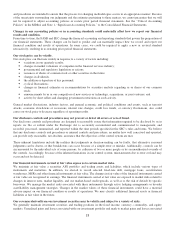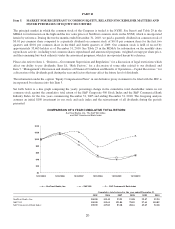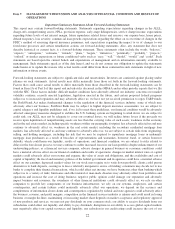SunTrust 2010 Annual Report Download - page 29
Download and view the complete annual report
Please find page 29 of the 2010 SunTrust annual report below. You can navigate through the pages in the report by either clicking on the pages listed below, or by using the keyword search tool below to find specific information within the annual report.Changes in market interest rates or capital markets could adversely affect our revenue and expense, the value of
assets and obligations, and the availability and cost of capital or liquidity.
Given our business mix, and the fact that most of the assets and liabilities are financial in nature, we tend to be sensitive to
market interest rate movements and the performance of the financial markets. In addition to the impact of the general
economy, changes in interest rates or in valuations in the debt or equity markets could directly impact us in one or more of
the following ways:
•The yield on earning assets and rates paid on interest-bearing liabilities may change in disproportionate ways;
•The value of certain balance sheet and off-balance sheet financial instruments or the value of equity investments that
we hold could decline;
•The value of assets for which we provide processing services could decline; or
•To the extent we access capital markets to raise funds to support our business, such changes could affect the cost of
such funds or the ability to raise such funds.
The fiscal and monetary policies of the federal government and its agencies could have a material adverse effect on
our earnings.
The Federal Reserve regulates the supply of money and credit in the U.S. Its policies determine in large part the cost of funds
for lending and investing and the return earned on those loans and investments, both of which affect the net interest margin.
They can also materially decrease the value of financial assets we hold, such as debt securities and MSRs. Its policies can
also adversely affect borrowers, potentially increasing the risk that they may fail to repay their loans. Changes in Federal
Reserve policies are beyond our control and difficult to predict; consequently, the impact of these changes on our activities
and results of operations is difficult to predict.
Depressed market values for our stock may require us to write down goodwill.
Numerous facts and circumstances are considered when evaluating the carrying value of our goodwill. One of those
considerations is the estimated fair value of each reporting unit. The fair value of a reporting unit is impacted by the reporting
unit’s expected financial performance and susceptibility to adverse economic, regulatory, and legislative changes. The
estimated fair values of the individual reporting units are assessed for reasonableness by reviewing a variety of indicators,
including our market capitalization evaluated over a reasonable period of time. While this comparison provides some relative
market information regarding the estimated fair value of the reporting units, it is not determinative and needs to be evaluated
in the context of the current economic and political environment. However, significant and/or sustained declines in our
market capitalization, especially in relation to our book value, could be an indication of potential impairment of goodwill.
Clients could pursue alternatives to bank deposits, causing us to lose a relatively inexpensive source of funding.
Checking and savings account balances and other forms of client deposits could decrease if clients perceive alternative
investments, such as the stock market, as providing superior expected returns. When clients move money out of bank
deposits in favor of alternative investments, we can lose a relatively inexpensive source of funds, increasing our funding
costs.
Consumers may decide not to use banks to complete their financial transactions, which could affect net income.
Technology and other changes now allow parties to complete financial transactions without banks. For example, consumers
can pay bills and transfer funds directly without banks. This process could result in the loss of fee income, as well as the loss
of client deposits and the income generated from those deposits.
We have businesses other than banking which subject us to a variety of risks.
We are a diversified financial services company. This diversity subjects earnings to a broader variety of risks and
uncertainties.
Hurricanes and other natural or man-made disasters may adversely affect loan portfolios and operations and increase
the cost of doing business.
Large scale natural or man-made disasters may significantly affect loan portfolios by damaging properties pledged as
collateral and by impairing the ability of certain borrowers to repay their loans. The nature and level of disasters cannot be
predicted and may be exacerbated by global climate change. The ultimate impact of a disaster on future financial results is
difficult to predict and will be affected by a number of factors, including the extent of damage to the collateral, the extent to
which damaged collateral is not covered by insurance, the extent to which unemployment and other economic conditions
caused by the disaster adversely affect the ability of borrowers to repay their loans, and the cost of collection and foreclosure
moratoriums, loan forbearances and other accommodations granted to borrowers and other clients.
13


